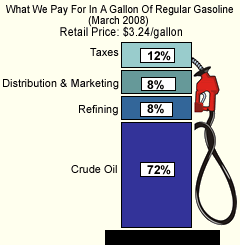
There are many components that go into the price at the pump for a gallon of gasoline, but the biggest component is the price of a barrel of oil.
For example, the average price of crude oil in 2007 was $72.34 per barrel. By March of 2008, the price of crude oil reached $105 per barrel, and crude oil accounted for 72 percent of the price of gasoline, as shown above. That is 25 percentage points more than in 2004, when the price for crude oil averaged only $36.98 a barrel.
The reasons for these higher crude oil prices are (1) increased demand, particularly from China, (2) production restraints by OPEC countries where some excess capacity does exist, and (3) market speculation about the availability of supplies affected by the political unrest in Iraq, Venezuela, and Nigeria. Also affecting the price is the weak U.S. dollar, which adds about $12 to a barrel of crude.
The second largest component to the price of gasoline is federal and state excise taxes. These taxes accounted for approximately 12 percent of the cost of a gallon of gasoline in March 2008 (and this figure does not include county and local excise taxes, or the profit, sales and property taxes that oil companies pay). Federal excise taxes amount to 18.4 cents per gallon while state excise taxes average about 21 cents a gallon.
The third component of gas prices is the retail dealer’s costs and profits, which constituted a combined 08 percent of the cost of a gallon of gasoline in March 2008. From the refinery, most gasoline is shipped first by pipeline to terminals near consuming areas, then loaded into trucks for delivery to individual stations. Some retail outlets are owned and operated by refiners, while most are independent businesses that purchase gasoline for resale to the public. The price at the pump reflects both the retailer’s purchase cost for the product and the other costs of operating the service station. It also reflects local market conditions and factors, such as the desirability of the location and the marketing strategy of the owner.
The last and smallest component of gas prices is the refining process, where crude oil is “cracked” and formulated into many different brands of gasoline. In March 2008, refinery costs comprised only 8 percent of the retail price of gasoline. This figure varies regionally because different parts of the country require different additives and processing steps in their gasoline formulations. The figure of 8 percent would also vary in other months, owing to seasonal changes in refinery operations. For example, in the spring when refineries need to retool to produce summer-blend gasoline and to meet summer gasoline demands, the cost of refinery operations is higher.



